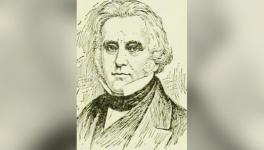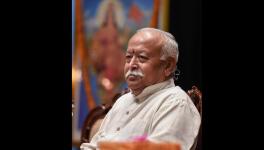Taj Mahal: Motivated Controversies Being Raised Again

Image Courtesy: Wikimedia Commons
Taj Mahal, regarded as one of the ‘Seven Wonders of the World’, is one of the major markers for India on the World map. It is a poem on marble; poet Guru Rabindranath Tagore described it as ‘drop of tear on the cheek of time’. Its beauty and fascination as a symbol of love is remarkable. It is a UNESCO heritage site and is maintained by the Archaeological Survey of India (ASI). It is a marvel on marble and its replicas were given gifts to visiting heads of state.
Since it was constructed by Mughal ruler Shahjahan in memory of his wife Mumtaz Mahal, it has been an eyesore for the Hindu Right. Though its history has been settled by the ASI and even the then Culture Minister Mahesh Sharma said that it was not a Shiv Temple, in 2017, during the Narendra Modi regime’s first term, controversies are being deliberately raised to widen the communal divide by Right-wing leaders and ideologues. Even ASI has time and again clarified it being a mausoleum and not a temple.
The first major controversy around the Taj Mahal was created with Bharatiya Janata Party’s (BJP) Yogi Adityanath becoming the Chief Minister of Uttar Pradesh. His tourism department published a booklet about sites of tourist attraction in UP. This booklet did not mention the Taj as one of the sites of tourist attraction, despite nearly 12,000 visitors being attracted to this marvel on a daily basis. It attracts 23% of tourists to India. When questioned, he retaliated that Taj does not reflect Indian culture.
Now another film by actor Paresh Rawal (a former BJP member of Parliament) is coming. Its trailer shows that as the Taj Mahal’s dome is lifted, Lord Shiva appears. The forthcoming film, The Taj Story, as it appears from its trailer, is an attempt to propagate the Taj as Tejo Mahalay, which was converted into a tomb by Shahjahan.
The argument of the forthcoming film is that Taj was a Hindu temple, Shiv Temple, Tejo Mahalay, built in the 4th Century (later revised to, say, 11th Century) and converted into a mausoleum by Mughal ruler Shahjahan. It being a 4th Century temple was put forward by a lawyer P.N. Oak.
Historian Ruchika Sharma rubbishes Oak on the basis of historical evidence, “But Oak, who did not know Farsi perhaps missed this vital detail that rubbishes his theory of the Taj being a reused 4th century palace. Historians such as Giles Tillotson also challenged Oak’s theory by asserting that the “technical know-how to create a building with the structural form of the Taj simply did not exist in pre-Mughal India”, she says.
The mystery of the 21 empty rooms at the bottom was also clarified by ASI. Architecturally, the empty rooms were meant to give stability to the structure, and were used for maintenance purposes. This was clarified during the Modi regime itself.
Once the 4th Century theory did not work, Oak revised it to say that it was a 12th Century temple. Sharma continues “Yet, Oak armed himself with make-believe and propaganda and petitioned the Supreme Court of India in July 2000, that the Taj was constructed by Raja Paramar Dev’s chief minister Salakshan in the 12th century and was therefore a Hindu structure “Tejo Mahalaya” and not made by Mughals.”
Oak went up to the Supreme Court to make his point, but the highest court rebuffed his fantasy that was “bereft of historical evidence”. His major argument was related to architectural aspects of the tomb, especially the dome at top, as an inverted lotus as well as the 21 empty rooms at the bottom. Similarly, later, one Amarnath Mishra approached the Allahabad High Court to petition that this was built by Chandela King, Parmadi. This was also dismissed by the court in 2005.
There are detailed accounts available about the construction of the Taj Mahal which are from immaculate historical sources. Peter Mundy and Tavernier, two travellers, mention that during their visit to India they came to know of Shahjahan’s grief and his determination to build a grand structure in memory of his wife, Mumtaz Mahal. Shahjahan made grand plans by involving the architects, the chief one being a Muslim (Ustad Ahmad Lahori) and his major associate being a Hindu architect. Badshah Nama, the biography of Shahjahan, gives a detailed account of the whole process, the group of people put together to plan and execute it.
The land chosen for Taj had belonged to Raja Jaisingh. There are two versions of the process of acquiring the land. One says that it was procured by giving due compensation, the other mentions that Raja Jaisingh gifted it to the emperor as they were on friendly terms.
The architecture of Taj Mahal is a reflection of the syncretic traditions that prevailed. The double dome structures were introduced by Mughal architects, Lal Kila (Red Fort) and Humayun’s Tomb being other examples of this. The Hindu temples had triangular superstructures. Later, domes were also introduced in temples. Architecture is not an exclusive process and the mixture of architectural styles is part of the process of civilisations.
Read Also: Aurangzeb, ‘Chhava’ and Selective Historiography
It is said that 20,000 artisans were hired to build Taj Mahal. As the Mughal administration used to have a construction division, the marvellous structures of North India are not a flash in the pan. Somehow the rumour made the rounds that the hands of these workers were cut. There is no source to substantiate this in any way.
The account books and documents of Shahjahan’s time amply tell us the detailed accounts of expenditure done to build the Taj. The account books mention the amounts spent to buy marble from Makrana and wages paid to the workers. Some prevalent Hindu motifs were made part of the structure, as Hindu architects and workers were part of the process of construction.
In a lighter vein, one should mention Oak’s fertile and banal imagination that puts the whole world civilisation having roots in Hindu culture. For him, Christianity is Krishna Niti; Vatican comes from Vatika and Rome from Ram! Despite his imagination based on such superficialities being devoid of any historical evidence, he kept publishing books and booklets that were circulated in Rashtriya Swayamsevak Sangh or RSS shakhas to propagate his theories with the aim to making them become a part of social understanding.
Most of the points raised by Rawal’s film (as shown in the trailer) on Taj Mahal were clarified a decade ago, yet the idea of reviving all this is a political one, as it helps the Hindu nationalist agenda of spreading hate against Mughal rulers, which is thereby reflected on today's Muslims.
The film is yet another propaganda film in the series of Kashmir Files, Bengal Files, Kerala Story and so many like these, whose aim is to intensify Right-wing propaganda. It adds on to that and will be yet another tool for divisiveness and hate ruling the roost in contemporary India.
The writer is a human rights activist, who taught at IIT Bombay. The views are personal.
Get the latest reports & analysis with people's perspective on Protests, movements & deep analytical videos, discussions of the current affairs in your Telegram app. Subscribe to NewsClick's Telegram channel & get Real-Time updates on stories, as they get published on our website.
























